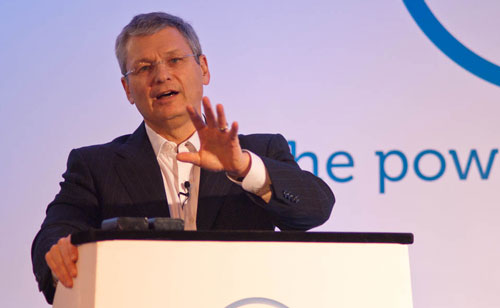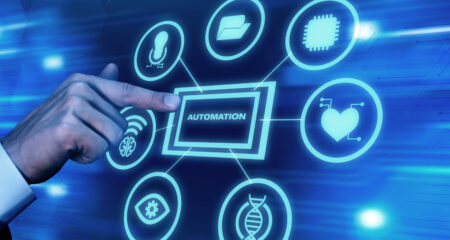
Computer maker Dell is “long longer a PC company” but an “IT solutions company”, Brad Anderson, the president of its enterprise solution group said at the launch of its enterprise solutions in London on Monday, Craig Wilson reports.
Anderson says the company has made 18 acquisitions since 2008, continues to invest in new data centres to match the increasing demand for cloud-based services, and has recently formed a software group.
Dell has realised it needs to play in more than just the hardware space if it hopes to compensate for the declining margins on physical products.
Once one of the biggest suppliers of PC hardware to large corporate organisations, partly due to its offering customers the ability to customise PC specifications and excellent after-sales services, the US company has suffered a decline in its fortunes in the face of a greater number of competitors and the consumerisation of technology where individuals increasingly want to use their own devices — particularly tablet computers — for work purposes.
Anderson says enterprise solutions and services now account for 30% of Dell’s business and it expects to buy about eight new companies a year for the foreseeable future.
He says Dell wants to offer “complete solutions around virtual desktop solutions” and realises the “speed of innovation isn’t the same globally”, so it will tailor what it rolls out, and when, to each region in which it is active.
The speed of innovation is accelerating every year, and Anderson says this creates market conditions that are excellent for companies that can move fast, but “unforgiving” of businesses that are late to market.
At the same time, computing power continues to increase at unprecedented rates. “In 1993, with the processing power available at the time, it was estimated it would take 10 years to map the human genome. With today’s computers, this can be done in 15 minutes.”
Anderson says the result is new business opportunities, like the ability to make designer or “custom” drugs for individuals that best match their individual genetic needs.
Dell on Monday also demonstrated some of its newest offerings for enterprises, some of which will only be made public next month. The most exciting of these is the fact that it will now be offering native support for 10Gbit/s Ethernet across its server, storage and networking portfolios.
Dell also announced two desktop virtualisation solutions. The first, Desktop Virtualization Solution Simplified is a small-scale virtualised desktop solution intended for small organisations. It integrates into existing systems and comes preconfigured. Desktop Virtualization Solution Enterprise, meanwhile, is a solution intended to scale to thousands of virtual desktop users.
Dell isn’t the first hardware manufacturer to try to expand its repertoire beyond the realm of hardware. Rival Hewlett-Packard acquired IT outsourcing company EDS in 2008, while IBM bought the consulting arm of auditing firm PricewaterhouseCoopers in 2002. Arguably, IBM has been the most adept at transforming its business and is reflected in its market value, which is US$232bn compared to HP’s $52bn and Dell’s $31bn. In the past decade, IBM’s share price has added 117% while HP’s has fallen by 32%. Dell is down by 26% over the same period.
Though it may appear that Dell is coming to the software and services game late, Adrian O’Connel, research director at analyst firm Gartner, says many of the company’s acquisitions in recent years have appeared to be hardware driven but have in reality been about the underlying software.
O’Connell says the first major deal in this vein was the purchase of data storage firm EqualLogic in 2007. “Lots of the functionality and value-add Dell gained was from the software components of that system.” He says the same holds true of the Compellent Fluid Data Systems acquisition that followed in 2010.
“Look at Perot, Scallent, and then Boomi on the cloud-integration front,” says O’Connell. “Those were all about the software functionality.” He says these all allow Dell to offer its various ‘as-a-service’ products.
According to O’Connell, there is distinct shift in the way IT is consumed and consequently there is a shift in the sorts of systems companies invest in, even those that aren’t overly eager to move everything to the cloud. He says the moves Dell has made in recent years point to its understanding that its “important from a vendor perspective to adjust to this”.
O’Connell says Dell has the advantage of “moving upstream without cannibalising its own business”. He adds that the company is being quite clear “about not having everything mapped out” but is “steadily making progress”.
When Dell acquired EqualLogic, the move “looked like a blip”, says O’Connell. He says Dell was “an organic company” that grew its PC business “rather than being acquisitive”. This, he says, was the starting point of the “transition to new Dell”.
He says the greatest challenge facing Dell is how to sell these new offerings. “The big challenges for Dell are coverage of the market. For all its good capabilities — like Perot on the services side — much of it is concentrated around the US.
“Dell needs to expand on that coverage more uniformly and focus on how its sales force interacts with customers. It was good at selling certain products to certain customers, but now it needs a whole different way to engage with customers. That’s the part that often gets overlooked.” — Craig Wilson, TechCentral
- Craig Wilson travelled to London as a guest of Dell’s
- Subscribe to our free daily newsletter
- Follow us on Twitter or on Google+ or on Facebook
- Visit our sister website, SportsCentral (still in beta)




